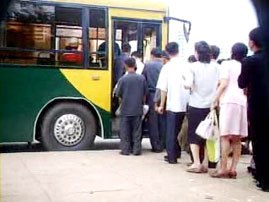“North Korean Market Vendors: The Rise of Grassroots Capitalists in a Post-Stalinist Society”
Andrei Lankov and Kim Seok-hyang
Pacific Affairs, Vol. 81 Iss.1
(subscription required)
Abstract:
The article deals with the social changes that have taken place in North Korea [from 1994-2002], when the collapse of the centrally planned economy led to the growth of private commercial activity. This activity remains technically illegal, but the relevant bans and restrictions have rarely been enforced due to endemic corruption and disorganization of the state bureaucracy. The article is largely based on in-depth interviews with North Korean black market operators [who have defected to South Korea]. It traces their origins, the type and scale of their business, and changes in their mode of operation.
The article demonstrates that the “second economy” came to dominate North Korean economic life by the late 1990s, since authorities’ attempts to limit its scale were largely ineffective. The growth of the “second economy” produced new grassroots capitalists who sometimes came from underpriveledged social groups, but more typically represented people with good official connections. It is also remarkable that foreign connections (usually with China) played a major role: to a large extent, merchandise sold at the North Korean markets either came from overseas or was exported overseas eventually, and in many cases the merchants’ initial capital was also provided by relatives residing overseas.
Some highlights:
1. Changsa is the North Korean word for “dealings in the marketplace.” Tonju is the word for money changers/lenders meaning “master of money”.
2. Public Distribution System (PDS) rations were cut for the first time in 1973.
3. The DPRK system restricted market activity primarily through three mechanisms: limited size of family farming plots, inminban surveillance system, and travel permits.
4. Before the arduous march, North Koreans were not inclined to resort to market trade. These transactions were seen as ethically suspect. Once the famine hit, people took up market trading remarkably quickly.
5. Before the arduous march, bribery was rare, even though patronage and indirect forms of corruption were rampant. Mid-level bureaucrats had to vie for preferred access to poor-quality consumer goods, better schools, and study trips abroad.
6. At the height of the arduous march (1997), production was at 46% of capacity.
7. North Korean traders seldom if ever have to deal with the protection racket. When asked directly, respondents did not mention threats from mobsters as one of their security concerns (I wonder if this is still the case).
8. Pyongsong market is reputed to be the largest in the country. It is just outside Pyongyang, making it accessible to citizens inside the capital as well as those who cannot get permits to enter the city (Pictured below with Google Earth coordinates).
Click on image for larger view
9. Financial services such as money-changers and private loan sharks offer loans at 5%-30%/month.
10. Most North Korean merchants know South Korea is a rich country. They also avoid surveillance since these activities are done at state-owned enterprises and study sessions.

 During the late 1990s, North Korea suffered a terrible economic collapse which resulted in famine and massive social dislocation. During this time, most ministries and state-owned companies were cash-strapped and unable to maintain their operations. Out of desperation they turned to private investment for much needed revenues by outsourcing many basic services. (Individuals who were capable of taking up such opportunities were probably small in number at the time, but apparently now compose a healthy sub-section of the population.)
During the late 1990s, North Korea suffered a terrible economic collapse which resulted in famine and massive social dislocation. During this time, most ministries and state-owned companies were cash-strapped and unable to maintain their operations. Out of desperation they turned to private investment for much needed revenues by outsourcing many basic services. (Individuals who were capable of taking up such opportunities were probably small in number at the time, but apparently now compose a healthy sub-section of the population.)